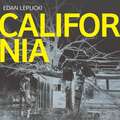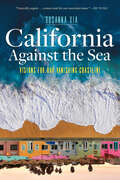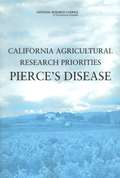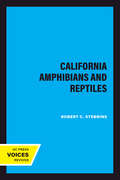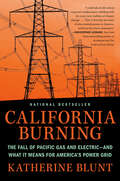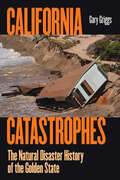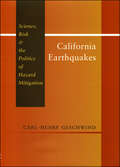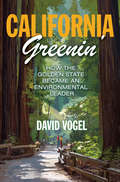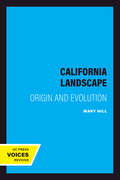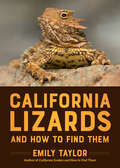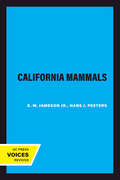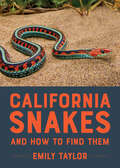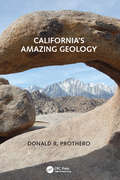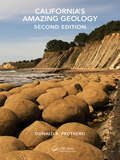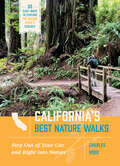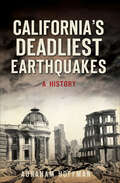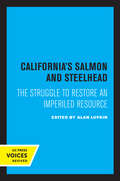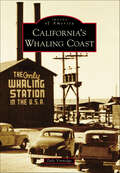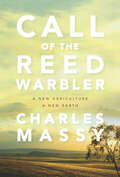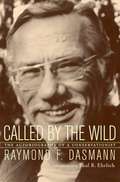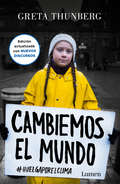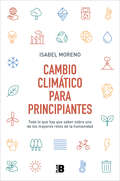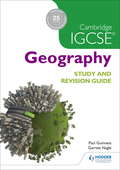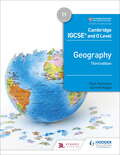- Table View
- List View
California
by Edan LepuckiThe highly acclaimed, instant New York Times bestseller that '[gives] expression to a generational anxiety about the near future, one rooted in the threat of environmental crisis...The experience of reading California brings validation to anyone who sits upright in the middle of the night struck with the instability of the human project on this planet: others are awake, too' GuardianThe sunshine state lies in darkness.Los Angeles is in ruins, left to the angels now.And the world Cal and Frida have always known is gone.Cal and Frida have left the crumbling city of Los Angeles far behind them. They now live in a shack in the wilderness, working side-by-side to make their days tolerable despite the isolation and hardships they face. Consumed by fear of the future and mourning for a past they can't reclaim, they seek comfort and solace in one other. But the tentative existence they've built for themselves is thrown into doubt when Frida finds out she's pregnant. Terrified of the unknown but unsure of their ability to raise a child alone, Cal and Frida set out for the nearest settlement, a guarded and paranoid community with dark secrets. These people can offer them security, but Cal and Frida soon realise this community poses its own dangers. In this unfamiliar world, where everything and everyone can be perceived as a threat, the couple must quickly decide whom to trust.A gripping and provocative debut novel by a stunning new talent,California imagines a frighteningly realistic near future, in which clashes between mankind's dark nature and irrepressible resilience force us to question how far we will go to protect the ones we love.
California
by Edan LepuckiThe sunshine state lies in darkness.Los Angeles is in ruins, left to the angels now.And the world Cal and Frida have always known is gone.Cal and Frida have left the crumbling city of Los Angeles far behind them. They now live in a shack in the wilderness, working side-by-side to make their days tolerable despite the isolation and hardships they face. Consumed by fear of the future and mourning for a past they can't reclaim, they seek comfort and solace in one other. But the tentative existence they've built for themselves is thrown into doubt when Frida finds out she's pregnant. Terrified of the unknown but unsure of their ability to raise a child alone, Cal and Frida set out for the nearest settlement, a guarded and paranoid community with dark secrets. These people can offer them security, but Cal and Frida soon realise this community poses its own dangers. In this unfamiliar world, where everything and everyone can be perceived as a threat, the couple must quickly decide whom to trust.A gripping and provocative debut novel by a stunning new talent, California imagines a frighteningly realistic near future, in which clashes between mankind's dark nature and irrepressible resilience force us to question how far we will go to protect the ones we love.
California Against the Sea: Visions for Our Vanishing Coastline
by Rosanna XiaPEN/E.O. Wilson Literary Science Writing Award Winner * Golden Poppy Award Winner for Nonfiction * California Book Awards Gold Medal Winner * A Great Read from Great Places selected by the Library of Congress * A San Francisco Chronicle Best Book of the Year * American Book Award Winner * 2024 American Energy Society's Energy Writer of the Year * An Architect's Newspaper Best Book of 2023 * 2024 Nautilus Book Awards Silver Medal WinnerNow in paperback: a "deeply researched and reported" (San Francisco Chronicle) exploration of sea level rise in California that "breathes exquisite detail and dialogue" (Science Magazine) into the subject."Viscerally urgent, thoroughly reported, and compellingly written—a must-read for our uncertain times." —Ed Yong, author of An Immense World"When do seawalls make sense? And when is it better to give in to the tides? [...] In California Against the Sea, Xia [...] writes about the difficult realities of trying to incorporate fairness into our tally of costs and benefits." —The New YorkerAlong California's 1,200-mile coastline, the overheated Pacific Ocean is rising and pressing in, imperiling both wildlife and the maritime towns and cities that 27 million people call home. In California Against the Sea, Los Angeles Times coastal reporter Rosanna Xia asks: As climate chaos threatens the places we love so fiercely, will we finally grasp our collective capacity for change?Xia, a Pulitzer Prize finalist, investigates the impacts of engineered landscapes, the market pressures of development, and the ecological activism and political scrimmages that have carved our contemporary coastline—and foretell even greater changes to our shores. From the beaches of the Mexican border up to the sheer-cliffed North Coast, the voices of Indigenous leaders, community activists, small-town mayors, urban engineers, and tenacious environmental scientists commingle. Together, they chronicle the challenges and urgency of forging a climate-wise future. Xia's investigation takes us to Imperial Beach, Los Angeles, Pacifica, Marin City, San Francisco, and beyond, weighing the rivaling arguments, agreements, compromises, and visions governing the State of California’s commitment to a coast for all. Through graceful reportage, she charts how the decisions we make today will determine where we go tomorrow: headlong into natural disaster, or toward an equitable refashioning of coastal stewardship.
California Agricultural Research Priorities Pierce's Disease
by Committee on California Agricultural Research Priorities: Pierce's DiseaseThe glassy-winged sharpshooter is one of the more recent invasive pests to afflict California agriculture. The insect transmits a bacterial pathogen that causes Pierce's disease, which has impaired production of wine, table, and raisin grapes in California. The report recommends strengthening the process and the priorities for research funded by state agencies and wine industry groups to address Pierce's disease and its vector. Research should be focused on identifying feasible options for controlling the spread of the disease and providing sustainable approaches that are adaptable and affordable over the long term. Several avenues of research be pursued more intensely including the genetic makeup of the pathogen that triggers Pierce's disease, understanding the mechanisms that make grapes resistant to the disease, the possibilities of introducing predator enemies to the sharpshooter, and new ways to manage the planting of crops to help avoid spread of the disease.
California Amphibians and Reptiles: Revised Edition (California Natural History Guides #31)
by Robert C. StebbinsThis title is part of UC Press's Voices Revived program, which commemorates University of California Press’s mission to seek out and cultivate the brightest minds and give them voice, reach, and impact. Drawing on a backlist dating to 1893, Voices Revived makes high-quality, peer-reviewed scholarship accessible once again using print-on-demand technology. This title was originally published in 1972.This title is part of UC Press's Voices Revived program, which commemorates University of California Press’s mission to seek out and cultivate the brightest minds and give them voice, reach, and impact. Drawing on a backlist dating to 1893, Voices Revived</DIV
California Burning: The Fall of Pacific Gas and Electric--and What It Means for America's Power Grid
by Katherine BluntA revelatory, urgent narrative with national implications, exploring the decline of California&’s largest utility company that led to countless wildfires — including the one that destroyed the town of Paradise — and the human cost of infrastructure failurePacific Gas and Electric was a legacy company built by innovators and visionaries, establishing California as a desirable home and economic powerhouse. In California Burning, Wall Street Journal reporter and Pulitzer finalist Katherine Blunt examines how that legacy fell apart—unraveling a long history of deadly failures in which Pacific Gas and Electric endangered millions of Northern Californians, through criminal neglect of its infrastructure. As PG&E prioritized profits and politics, power lines went unchecked—until a rusted hook purchased for 56 cents in 1921 split in two, sparking the deadliest wildfire in California history.Beginning with PG&E&’s public reckoning after the Paradise fire, Blunt chronicles the evolution of PG&E&’s shareholder base, from innovators who built some of California's first long-distance power lines to aggressive investors keen on reaping dividends. Following key players through pivotal decisions and legal battles, California Burning reveals the forces that shaped the plight of PG&E: deregulation and market-gaming led by Enron Corp., an unyielding push for renewable energy, and a swift increase in wildfire risk throughout the West, while regulators and lawmakers pushed their own agendas.California Burning is a deeply reported, character-driven narrative, the story of a disaster expanding into a much bigger exploration of accountability. It&’s an American tragedy that serves as a cautionary tale for utilities across the nation—especially as climate change makes aging infrastructure more vulnerable, with potentially fatal consequences.
California Catastrophes: The Natural Disaster History of the Golden State
by Gary GriggsThis comprehensive account of California’s numerous and perilous natural disasters explores how a unique combination of forces has affected Californians throughout the state's history and carries a sobering message about our short disaster memories. California has more natural hazards per square mile than any other state, but this hasn’t deterred people from moving here. Entire California towns and regions frequently contend with destruction caused by earthquakes, floods, landslides and debris flows, and sea-level rise and coastal erosion. As Gary Griggs demonstrates in California Catastrophes, few years go by without a disaster of some kind, and residents often rebuild in the same locations that were just destroyed. Considering the current climate crisis and increasing environmental inequalities, the stakes are growing ever higher. This book dives into the history of the state’s vulnerability to natural hazards, why and where these events occur, and how Californians can better prepare going forward. A mix of photographs and maps both historical and contemporary orients readers within the state’s sprawling landscapes and provides glimpses of some of the geologic risks in each region. With the final chapter, Griggs issues a call to action and challenges readers to envision a safer, more equitable, and sustainable future.
California Earthquakes: Science, Risk, and the Politics of Hazard Mitigation
by Carl-Henry GeschwindWinner of the Book Prize of the Forum for the History of Science in America from the History of Science SocietyIn 1906, after an earthquake wiped out much of San Francisco, leading California officials and scientists described the disaster as a one-time occurrence and assured the public that it had nothing to worry about. California Earthquakes explains how, over time, this attitude changed, and Californians came to accept earthquakes as a significant threat, as well as to understand how science and technology could reduce this threat.Carl-Henry Geschwind tells the story of the small group of scientists and engineers who—in tension with real estate speculators and other pro-growth forces, private and public—developed the scientific and political infrastructure necessary to implement greater earthquake awareness. Through their political connections, these reformers succeeded in building a state apparatus in which regulators could work together with scientists and engineers to reduce earthquake hazards. Geschwind details the conflicts among scientists and engineers about how best to reduce these risks, and he outlines the dramatic twentieth-century advances in our understanding of earthquakes—their causes and how we can try to prepare for them.Tracing the history of seismology and the rise of the regulatory state and of environmental awareness, California Earthquakes tells how earthquake-hazard management came about, why some groups assisted and others fought it, and how scientists and engineers helped shape it.
California Greenin': How the Golden State Became an Environmental Leader (Princeton Studies in American Politics: Historical, International, and Comparative Perspectives #157)
by David VogelA political history of environmental policy and regulation in California, from the Gold Rush to the presentOver the course of its 150-year history, California has successfully protected its scenic wilderness areas, restricted coastal oil drilling, regulated automobile emissions, preserved coastal access, improved energy efficiency, and, most recently, addressed global climate change. How has this state, more than any other, enacted so many innovative and stringent environmental regulations over such a long period of time? The first comprehensive look at California's history of environmental leadership, California Greenin' shows why the Golden State has been at the forefront in setting new environmental standards, often leading the rest of the nation.From the establishment of Yosemite, America's first protected wilderness, and the prohibition of dumping gold-mining debris in the nineteenth century to sweeping climate- change legislation in the twenty-first, David Vogel traces California's remarkable environmental policy trajectory. He explains that this pathbreaking role developed because California had more to lose from environmental deterioration and more to gain from preserving its stunning natural geography. As a result, citizens and civic groups effectively mobilized to protect and restore their state's natural beauty and, importantly, were often backed both by business interests and bystrong regulatory authorities. Business support for environmental regulation in California reveals that strict standards are not only compatible with economic growth but can also contribute to it. Vogel also examines areas where California has fallen short, particularly in water management and the state's dependence on automobile transportation. As environmental policy debates continue to grow more heated, California Greenin' demonstrates that the Golden State's impressive record of environmental accomplishments holds lessons not just for the country but for the world.
California Landscape: Origin and Evolution (California Natural History Guides #48)
by Mary HillThis title is part of UC Press's Voices Revived program, which commemorates University of California Press’s mission to seek out and cultivate the brightest minds and give them voice, reach, and impact. Drawing on a backlist dating to 1893, Voices Revived makes high-quality, peer-reviewed scholarship accessible once again using print-on-demand technology. This title was originally published in 1984.
California Lizards and How to Find Them (California Herping Guides)
by Emily TaylorThe author of California Snakes and How to Find Them invites budding reptile enthusiasts into a wonderland of lizards."This guide joyfully celebrates the beauty and quirkiness of our native lizards." —John Muir LawsLizards: they are cute, endearing, and mind-bogglingly diverse, and yet they are so easy to overlook among California’s natural abundance. Start watching them, though, and a wonderland of lizard life appears. In California Lizards and How to Find Them, lizard lover Emily Taylor profiles over 60 native and introduced species, from California's iconic Western Fence Lizard to the adorable Desert Iguana to the chonky Ringed Wall Gecko. With her expert knowledge and joyous, laugh-out-loud writing, Taylor provides tips for finding, watching, and responsibly catching lizards. She offers absorbing insights on lizard evolution, and she explains the toll of invasive lizard species on California's ecosystems. Featuring more than 100 full-color photographs, and designed for easy use in everyday life, this is the ideal guide for budding reptile enthusiasts and longtime naturalists alike.
California Mammals (California Natural History Guides #52)
by E. W. Jameson Jr. Hans J. PeetersThis title is part of UC Press's Voices Revived program, which commemorates University of California Press’s mission to seek out and cultivate the brightest minds and give them voice, reach, and impact. Drawing on a backlist dating to 1893, Voices Revived makes high-quality, peer-reviewed scholarship accessible once again using print-on-demand technology. This title was originally published in 1988.This title is part of UC Press's Voices Revived program, which commemorates University of California Press’s mission to seek out and cultivate the brightest minds and give them voice, reach, and impact. Drawing on a backlist dating to 1893, Voices Revived</DIV
California Snakes and How to Find Them
by Emily TaylorA herpetologist introduces budding snake enthusiasts to the wonders of California snakes."I've loved snakes since childhood and am thrilled to now have this gorgeous book as my companion to finding snakes wherever a walk on the wild side takes me." —Amy Tan, author of The Joy Luck Club and The Backyard Bird ChroniclesFear of snakes is one of the most common phobias in the world, yet step into any local zoo and you'll find the snake pit to be among these menageries' greatest attractions. In this entrancing ode to the charms of California's legless reptiles, rattlesnake wrangler Emily Taylor shares her knowledge, enthusiasm, and advice for getting to know our slithering neighbors, dispelling the usual misapprehensions that surround them and celebrating their striking biological traits along the way.Featuring profiles of the nearly 50 fork-tongued species that burrow and coil in California's diverse habitats, and containing tips for serpent seekers—including identification guides and handling advice—California Snakes and How to Find Them delves into the longstanding myths and latest natural history research on our ophidian friends of the West. Taylor showcases the biodiversity of California's snakes, from the Common Garter to the fetchingly pink Rosy Boa to the elusive Alameda Striped Racer, illustrated with more than 100 detailed photographs. Supported with critical insights—such as what to do during a venomous encounter, and an exploration of the seemingly simple question, What is a snake?—this guide is the perfect companion for both the seasoned naturalist and the budding snake enthusiast.
California's Amazing Geology
by Donald R. ProtheroCalifornia has some of the most distinctive and unique geology in the United States. It is the only state with all three types of plate boundaries, an extraordinary history of earthquakes and volcanoes, and it has many rocks and minerals found nowhere else. The Golden State includes both the highest and lowest point in the continental US and practically every conceivable geological feature known. This book discusses not only the important geologic features of each region in California, but also the complex geologic four-dimensional puzzle of how California was assembled, beginning over 2 billion years ago. The author provides up-to-date and authoritative review of the geology and geomorphology of each geologic province, as well as recent revelations of tectonic history of California’s past. There are separate chapters on some of California’s distinctive geologic resources, including gold, oil, water, coastlines, and fossils. An introductory section describes basic rock and mineral types and fundamental aspects of plate tectonics, so that students and other readers can make sense of the bizarre, wild, and crazy jigsaw puzzle that is California's geological history.
California's Amazing Geology
by Donald R. ProtheroCalifornia has some of the most distinctive and unique geology in the United States. It is the only state with all three types of plate boundaries, an extraordinary history of earthquakes and volcanoes, and many rocks and minerals found nowhere else. The Golden State includes both the highest and lowest points in the continental US and practically every conceivable geological feature known. This book discusses not only the important geologic features of each region in California but also the complex geologic four-dimensional puzzle of how California was assembled, beginning over two billion years ago. The author provides an up-to-date and authoritative review of the geology and geomorphology of each geologic province, as well as recent revelations of the tectonic history of California’s past. There are separate chapters on some of California’s distinctive geologic resources, including gold, oil, water, coastlines, and fossils. An introductory section describes basic rock and mineral types and fundamental aspects of plate tectonics, so that students and other readers can make sense of the bizarre, wild, and crazy jigsaw puzzle that is California's geological history.In this second edition, the book has an entirely new final section, “California’s Environmental Hazards and Challenges,” with new chapters on California’s landslides, air and water pollution, renewable energy, and the future of climate change in California.Key Features Thoroughly updates the market-leading textbook on California's geology Is written by an author with 30 years of teaching geology and leading field trips in California Introduces California's unique geological history Covers fundamentals of geology Characterizes specific geographical regions of California Describes major geological resources of California Summarizes the paleontology of California Reviews the likely impact of climate change on California's environment Related TitlesHollocher, K. A Pictorial Guide to Metamorphic Rocks in the Field (ISBN 978-11380-2630-8)Glavovic, B. et al. Climate Change and the Coast: Building Resilient Communities (ISBN 978-04154-6487-1)
California's Best Nature Walks: 32 Easy Ways to Explore the Golden State's Ecology
by Charles HoodExplore some of California&’s most exquisite landscapes with this accessible hiking guidebook featuring descriptions of the flora, fauna, and ecology hikers will discover along the trail. See the oldest trees in the world—and the tallest. Meet earthquake-loving fish, lively island foxes, and endemic birds. Visit the saltwater homes to sea otters and a desert basin where the water is even saltier. In California&’s Best Nature Walks, Charles Hood reveals the golden state&’s unique ecosystems, guiding you through 32 spectacular natural areas, with advice on deciphering the terrain. All are within easy walking distance of the road. This is an essential companion for road-trippers, outdoor enthusiasts, and day hikers—no cleated boots or trekking poles necessary. Locations include the Arcata Marsh and Wildlife Sanctuary, McConnell Arboretum and Botanical Gardens, Olmsted Point at Yosemite National Park, Fossil Falls, Camp Roberts Rest Area along Highway 101, Scorpion Anchorage at Channel Islands National Park, Vasquez Rocks Natural Area, and more!
California's Deadliest Earthquakes: A History (Disaster Ser.)
by Abraham HoffmanA detailed look at the state&’s most terrifying and destructive disasters—photos included. Home to hundreds of faults, California leads the nation in frequency of earthquakes every year. And despite enduring their share of the natural disasters, residents still speculate over the inevitable &“big one.&” More than three thousand people lost their lives during the 1906 San Francisco earthquake. Long Beach&’s 1933 earthquake caused nearly $50 million in damages. And the Northridge earthquake injured thousands and left a $550 million economic hit. In this book, historian Abraham Hoffman explores the personal accounts and aftermath of California&’s most destructive tremors.
California's Salmon and Steelhead: The Struggle to Restore an Imperiled Resource
by Alan LufkinMillions upon millions of salmon and steelhead once filled California streams, providing a plentiful and sustainable food resource for the original peoples of the region. But over the years, dams and irrigation diversions have reduced natural spawning habitat from an estimated 6,000 miles to fewer than 300. River pollution has also hit hard at fish populations, which within recent decades have diminished by 80 percent. One species, the San Joaquin River spring chinook, became extinct soon after World War II. Other species are nearly extinct. This volume documents the reasons for the decline; it also offers practical suggestions about how the decline might be reversed. The California salmon story is presented here in human perspective: its broad historical, economic, cultural, and political facets, as well as the biological, are all treated. No comparable work has ever been published, although some of the material has been available for half a century. In the richly varied contributions in this volume, the reader meets Indians whose history is tied to the history of the salmon and steelhead upon which they depend; commercial trollers who see their livelihood and unique lifestyle vanishing; biologists and fishery managers alarmed at the loss of river water habitable by fish and at the effects of hatcheries on native gene pools. Women who fish, conservation-minded citizens, foresters, economists, outdoor writers, engineers, politicians, city youth restoring streambeds—all are represented. Their lives—and the lives of all Californians—are affected in myriad ways by the fate of California's salmon and steelhead. This title is part of UC Press's Voices Revived program, which commemorates University of California Press’s mission to seek out and cultivate the brightest minds and give them voice, reach, and impact. Drawing on a backlist dating to 1893, Voices Revived makes high-quality, peer-reviewed scholarship accessible once again using print-on-demand technology. This title was originally published in 1991.
California's Whaling Coast
by Dale VinnedgeYankee whaling, shore whaling, and modern whaling were sometimes occurring simultaneously. Each type of whaling went through periods of discovery, stability, and then a gradual decrease as the products lost their markets or the number of whales began to wane as some species moved toward commercial if not actual extinction due to over-fishing. Small whaling operations from California, called shore whaling, continued from the 1850s until Secretary of Commerce Maurice Stans (1969�1972) whistled down the industry in 1971.
Call of the Reed Warbler: A New Agriculture, A New Earth
by Charles Massy&“Charles Massy has written a definitive masterpiece that takes its place along with the writings of Aldo Leopold, Wendell Berry, Masanobu Fukuoka, Humberto Maturana, and Michael Pollan. No work has more brilliantly defined regenerative agriculture and the breadth of its restorative impact upon human health, biodiversity, climate, and ecological intelligence.&”—Paul HawkenIn Call of the Reed Warbler, Charles Massy explores regenerative agriculture and the vital connection between our soil and our health.It is the story of how a grassroots revolution—a true underground insurgency—can save the planet, help reduce and reverse climate change, and build healthy people and healthy communities, pivoting significantly on our relationship with growing and consuming food.Using his personal experience as a touchstone—from an unknowing, chemical-using farmer with dead soils to a radical ecologist farmer carefully regenerating a 2000-hectare property to a state of natural health—Massy tells the real story behind industrial agriculture and the global profit-obsessed corporations driving it. With evocative stories, he shows how other innovative and courageous farmers are finding a new way.At stake is not only a revolution in human health and in our communities, but the very survival of the planet. For farmers, backyard gardeners, food buyers, health workers, policy makers, and public leaders alike, Call of the Reed Warbler offers a tangible path forward and a powerful and moving paean of hope.It&’s not too late to regenerate the earth. Call of the Reed Warbler shows the way forward for the future of our food supply, our planet, and our health.&“Part lyrical nature writing, part storytelling, part solid scientific evidence, part scholarly research, part memoir, [this] book is an elegant manifesto, an urgent call to stop trashing the Earth and start healing it.&”—The Guardian
Called by the Wild: An Autobiography of a Conservationist
by Raymond Fredric DasmannThis delightful memoir tells the story of an unpretentious man who helped create and shape today's environmental movement. This autobiography is a story of international conservation action and intrigue, a moving love story, and a gripping chronicle of an exceptional life.
Cambiemos el mundo (Nueva edición actualizada): #huelgaporelclima
by Greta Thunberg«SOY GRETA THUNBERG, TENGO QUINCE AÑOS Y HABLO EN NOMBRE DE LA JUSTICIA CLIMÁTICA. ESTE ES UN GRITO DE SOCORRO.» El cambio climático pronto será irreversible. Los políticos no van a reaccionar. Tal vez tú sí. #huelgaporelclima Greta Thunberg es una adolescente sueca que se ha propuesto luchar contra el cambio climático y por la supervivencia del ser humano. En agosto de 2018 comenzó una huelga escolar los viernes que ahora siguen cientos de miles de estudiantes en todo el mundo. En diciembre de 2018 fue invitada por las Naciones Unidas a hablar en la cumbre sobre el cambio climático. Poco después atravesó Europa en tren para llegar a la fría ciudad suiza de Davos, donde se alojó en una carpa, para hablarante los líderes del mundo en el Foro Económico Mundial: «Quiero que entren en pánico -les dijo-. Quiero que actúen como si nuestra casa estuviera ardiendo. Porque así es». Hoy, Greta Thunberg es candidata al Premio Nobel de la Paz. Esta nueva edición ampliada recoge todos sus discursos hasta hoy. La crítica ha dicho...«Greta Thunberg, la activista que vino del frío para frenar el calentamiento global, es la chica de moda de los medios de comunicación, la Juana de Arco del siglo XXI, la Agustina de Aragón de todo el planeta, la nueva María Pita. De vez en cuando aparece en la historia la figura de una joven sin mácula que revoluciona su entorno por su lucha sin descanso por su causa justa.»Rosa Martí, Esquire «Greta arde de autenticidad, es un puro aullido de desesperación y de incredulidad ante nuestra ceguera.»Rosa Montero «Con su discurso ha irrumpido como un ciclón desde la sociedad civil sueca para poner en primer plano la lucha contra el cambio climático. [...] La generación posmilenial tiene un nombre y una autora clave a la que seguir.»El Ojo Crítico (RNE 1) «Si la humanidad gana un día la batalla contra el cambio climático podrá agradecérselo a esta joven testaruda que armada con un gorro de lana y sus trenzas ha tenido éxito donde miles de científicos y militantes han fracasado.»Le Soir «Un libro que todos los adultos tendrían que leer y que consideramos casi lectura obligada para las nuevas generaciones.»Qué Leer «Greta Thunberg se atreve a decir lo que casi todos callan.»Lola Fernández, Cosmopolitan «Apenas 72 páginas cargadas de lucidez, rebeldía e impaciencia.»Tino Pertierra, La Opinión «Invitar a Greta Thunberg es un acto de alto riesgo. La adolescente sueca de dieciséis años ha irrumpido como un ciclón desde ese ente abstracto llamado sociedad civil para devolverla lucha contra el cambio climático a un primer plano. Su retórica deslenguada ha cautivado a cientos de miles de estudiantes y la ha convertido en una suerte de estrella pop. Su estela deja altas dosis de reproches a unas élites habituadas a la complacencia y acostumbradas a emplear ante los jóvenes un discurso cargado de buenas intenciones, pero a menudo vacío y paternalista.»El País «La generación Z o post millenial tiene un nombre de mujer: Greta Thunberg, una escolar sueca de dieciséis años cuya protesta contra la inacción de los gobiernos frente al cambio climático se ha extendido como un reguero de pólvora por numerosos países.»La Vanguardia «Todo es inquietante en Greta Thunberg. Su mirada, su sonrisa jamás completa, sus frases cortas llenas de contenido, sus silencios, su timidez. Y la incapacidad de mentir y de dejar pasar las cosas, la obstinación, la nobleza, la sinceridad, la carencia de maldad o la certeza de que no hay grises,
Cambio climático para principiantes: Todo lo que hay que saber sobre uno de los mayores retos de la humanidad
by Isabel Moreno¿Qué es el cambio climático? ¿Es un fenómeno provocado por los seres humanos? ¿De dónde proceden las emisiones de gases de efecto invernadero? Si el mundo se está calentando, ¿por qué se producen olas de frío o nevadas históricas? ¿Hay vuelta atrás para evitar una catástrofe climática? El cambio climático es una realidad incuestionable. El aumento de las temperaturas está causando consecuencias preocupantes en cada rincón del planeta, por lo que debemos actuar urgentemente. Con este libro entenderemos las bases del cambio climático a través de un viaje por tierra, mar, aire e incluso resbalando por el hielo. Comprenderemos los orígenes de esta crisis, por qué se dan fenómenos tan dispares como inundaciones o sequías y, sobre todo, descubriremos por qué un problema aparentemente sencillo es en realidad uno de los mayores retos a los que se enfrentala humanidad hoy en día. EL MAÑANA DEPENDE DE LAS DECISIONES QUE SE TOMEN HOY.
Cambridge IGCSE Geography Study and Revision Guide
by Garrett Nagle Paul Guinness- Check your knowledge of all the essential syllabus content and concepts- Specifies the skills and knowledge that students need to acquire during the course- Highlights common misconceptions and errors- Tests knowledge with practice questions and answers at the back of the book- Get it right with common misconceptions and errors highlightedThis title has not been through the Cambridge International Examinations endorsement process.
Cambridge IGCSE and O Level Geography 3rd edition
by Garrett Nagle Paul GuinnessThis title is endorsed by Cambridge Assessment International Education to support the full syllabus for examination from 2020.Critically observe and investigate the three geographical themes in the latest Cambridge IGCSE and O Level Geography syllabuses (0460//0976/2217) and ensure full coverage with a comprehensive guide to all themes, skills and coursework required. - Trust experienced authors and teachers to guide you through the required topics and facts. - Navigate the syllabuses confidently with relevant key questions at the start of each chapter.- Deepen understanding of geographical concepts through up-to-date case studies from around the world. - Check comprehension with case study analyses and activities throughout. - Consolidate learning with definitions of key terms, topic summaries, additional questions, further help with case studies and images online.Available in this series:Student Textbook Third edition (ISBN 9781510421363)Student eTextbook (ISBN 9781510420359) Whiteboard eTextbook (ISBN 9781510420366) Workbook (ISBN 9781510421387)Online Teacher's Guide (ISBN 9781510424166)Study and Revision Guide (ISBN 9781510421394)

